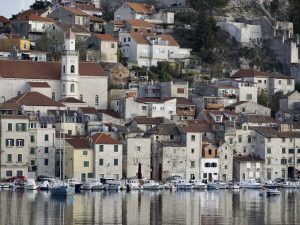Croatia’s capital city of Zagreb has a modern airport which makes a positive first impression even in bad weather. We have grown accustomed to arriving in the rain lately but for the first time in our travels we took a taxi to our hotel instead of walking (okay, we had a rental car in Iceland and our friends picked us up in Marseille, but this was only our second actual taxi in over two months; the first was to go see Pavarotti’s house.). The advantage of trains over airplanes is that they pick you up and drop you off in the middle of the cities as opposed to landing in an airport 15 miles from the city center.
Having been to Croatia with the Navy and knowing a bit about its history as a part of the former Yugoslavia, my impression of the airport is that Croatia is a country trying really hard to make up for lost time behind the Iron Curtain. You see this in their buildings, their attitudes, and their promotion of Croatia as a destination in a positive and admirable way. It feels optimistic.
It was 10 p.m. when we landed so the taxi ride to the city center was cold, wet, and dark. Adding to the positive first impressions, though, when we got in the car, we were welcomed by Bryan Adam’s “Summer of ’69” playing on the radio. During the drive we heard Dire Straits, Madonna, and Boy George, all interlaced with catchy Croatian pop music. Maybe it was the age of our driver (he was as old like us) and maybe the Croatians just have good taste and embrace the ’80s vibe. Over the next two days, we hard Bonnie Tyler’s “Total Eclipse of the Heart” and “I Need a Hero” more than once each. I’m thinking it’s good taste.
The positive impressions took a bit of a sharp left lurching turn when we got to our hotel, but that was mostly my fault. Zagreb is a capital city and we learned that, like many other capital cities, a dollar just doesn’t go as far. Trying to stay on a budget, I had booked an “apartment” hostel that seemed nice enough online but was in the sub-basement of a Cold War era concrete building with very poor outdoor lighting and very little in the way of identification on the façade. Our taxi driver expressed some doubt that he had brought us to the right place; I’m sure 50 year old Americans who take a taxi usually get dropped off at a building that at least has a lit sign in front identifying it as a hotel. We had to ring the bell three times (in the rain) before the door finally buzzed to let us in. The owner(?) of the hostel was nice enough but he was older and kind of grizzly both in his appearance and manner. Our room was clean and functional with a nice little bathroom, but it was decorated and lighted in the “basement bleak” style with all the ambiance you’d expect from watching Cold War era spy movies. Had we arrived in the daylight (or sunlight), maybe our first impression wouldn’t have been quite so rough.
Zagreb has street cars and our hostel was on the corner where the trams made a 90 degree turn. Once we turned off the lights and went to bed, we realized you could feel and hear the low rumble every couple minutes as the trams went by. It was subtle enough to be soothing and, to me, added to the ambiance of the whole experience. One hidden advantage of a sub basement is that we had just one small window that looked onto a wall so our room was dark like a cave. Despite the not-so-great first impression, we slept great and quickly adapted to this little room in the basement for two nights and even discovered the TV could play Netflix shows (we watched a couple episodes of ‘The Crown’ on someone else’s login). Waking up without any bug bites was a bonus, too. We didn’t see many of the other guests but the ones we did see were, not surprisingly, in their 20s and carrying backpacks. Lyn thankfully is a good sport about traveling on a budget but this was a little more budget than I had intended. We will be back in Zagreb for five days at the end of our Croatia time, so I can assure you we (I) will choose a bit more wisely next time.
A Zany Time Zone
For the unfortunate handful of people that have endured my previous posts, you probably recall hearing me complain about how late the sun came up in northwest Spain because it artificially follows the same time zone as the rest of Europe. Pontevedra is at 8.5°W and Zagreb is at 16°E. That’s a 24.5° difference. For context, Dallas and Los Angeles are fewer than 22° of longitude (and two time zones) apart. In a normal world, where each time zone should be 15° of longitude (15° x 24 = 360°), Pontevedra and Zagreb should be at least one time zone apart (if not two). Moving from the extreme western side of an abnormally large time zone to the extreme eastern side of it, we consequently went from crazy late sunrises to crazy early sunsets. On our first day in Zagreb (Nov 17th), sunrise was at 6:59 a.m. and sunset was at 4:22 p.m. I get that it’s mid-November and Zagreb is at 45°N (about the same as Green Bay, Wisconsin) so the days are already short. Our problem was that the late sunrises had conditioned us to wake up late and now that habit is literally costing us daylight.
Welcome to the Eurozone
As of November 2022, Croatia is a member of the European Union (EU) which governs political and economic relationships between member nations. Croatia is currently NOT a member of the Eurozone which governs monetary policy through a common currency (the Euro); Croatia currency is the Kuna. Also, Croatia is NOT a member of the Schengen Zone which governs free mobility across the internal borders of member nations. I should also give Croatia credit for being a NATO member as well.
Croatia, however, WILL BECOME a member of the Eurozone on January 1st, 2023 (just over a month from now). In July 2022, as a transition step to Eurozone entry, the European Central Bank set the exchange rate for the Croatian Kuna which effectively pegged it to the Euro. Thus the USD/Euro exchange rate moves pretty much in tandem with the USD/Kuna exchange rate. What we have seen so far is that almost all the restaurants list their prices in both Kuna and Euro using the fixed exchange rate, which is 7.53 Kuna per Euro. The currencies are essentially interchangeable and they seem well postured for the transition. No doubt the EU has applied lessons and worked out their playbook for bringing new nations into the Eurozone during the 30 years since the EU was created.
Welcome to the Schengen Zone?
Croatia is also aspiring to join the Schengen Zone which is not automatic with the Eurozone, but they tend to happen together because both rely on the nation meeting a set criteria and because the seamless movement of people across borders is a lot easier with seamless movement of their money. As I understand from an EU press release, the “on 8 December the [EU] Justice and Home Affairs Council will vote on the full participation of Bulgaria, Romania and Croatia to the Schengen area without internal border controls”. Full analysis available here.
Croatia will certainly benefit in many ways from joining the Eurozone and Schengen Agreement. Simply put, they will become full fledged members of the European Union in all respects and will enjoy the economic advantages that come from free movement across borders and an easy transfer of money in the same currency. Some economists and monetary experts would remind you that a fixed currency comes with some drawbacks for small nations, too. Just ask Greece. One drawback is that many long-term tourists (like us) come to Croatia specifically because it is outside the Schengen Zone and it does not count against the Schengen Area’s 90-day tourist visa limits. To be clear, this is 90 days within a 180 day window, so a tourist could spend 90 days in Italy then 90 days in Croatia and then 90 days in Italy and repeat this cycle indefinitely. With Croatia, Bulgaria, and Romania on course to join the Schengen Zone, where will the new haven be for people on an extended visit to Europe. I’m thinking it might be a good time to buy a condo in Montenegro, Albania, or Morocco. To be clear, I am NOT a real estate speculator and have no intention to buy property anywhere except maybe in Wisconsin. Maybe.
If you want to learn more about the member nations in NATO, the EU, the Eurozone, and the Schengen Agreement, this is one of the better and simpler graphics I came across.
Seeing the Sights in Zagreb
A lot of tourist guides say something like “people come to Croatia to visit the beaches and islands but you really should spend a day enjoying Zagreb.” With 32 days in Croatia during the “low season” season, our plan is to visit the coast but forego the islands, which gives us some bandwidth for spending time in Zagreb. We budgeted two days up front to get our bearings and as a hedge if our bags got lost in Frankfurt (the airlines seem to have gotten better with baggage lately?). We are flying out of Zagreb on December 18th and have budgeted five days on the backend primarily to enjoy the city’s famous Christmas markets. As we walked around, we saw Croatians busy at work rigging lights in the parks and city streets and constructing what we expect will be the stalls and infrastructure for the Christmas markets.
Much like Madrid, we have the luxury of knowing we’ll be back so set fairly low expectations for this orientation period. The historic center of Zagreb is fairly compact so, like the guidebooks suggest, you can cover a lot of ground and see many key attractions in an earnest day or sightseeing.
The Main Square and a Bit of Croatian History
The main square is called Ban Jelačić Square and it is definitely the place you always seem to find over and over again because it links the organized and gridded lower town from the older twisty and winding upper town. The word “Ban” means something like viceroy so it’s kind of like saying “President Washington Square.” His full name is Count Josip Jelačić von Bužim (don’t ask me how to pronounce it).
Ban Jelačić himself is indeed something like the father of modern Croatia but, not entirely unlike George Washington, his biography has its dark edges. As near as I can simplify it, he played mom and against dad when the Hapsburgs in Vienna were not getting along with the Hungarians in the 1840s. Croatia was a Hungarian vassal and Ban Jelačić basically declared freedom from Hungary in exchange for autonomy under the Habsburgs. His historical reputation thus varies widely depending on which country’s history book you are reading. Unlike the American Revolution and the “birth of a new nation”, the aftermath of that moment is an historically messy century, but it was the first step in a chain that eventually led to an independent Croatia (150 years later). Trying to understand that chain of events makes you appreciate the deep complexities in this part of Europe that sparked World War I with the assassination of Archduke Franz Ferdinand.
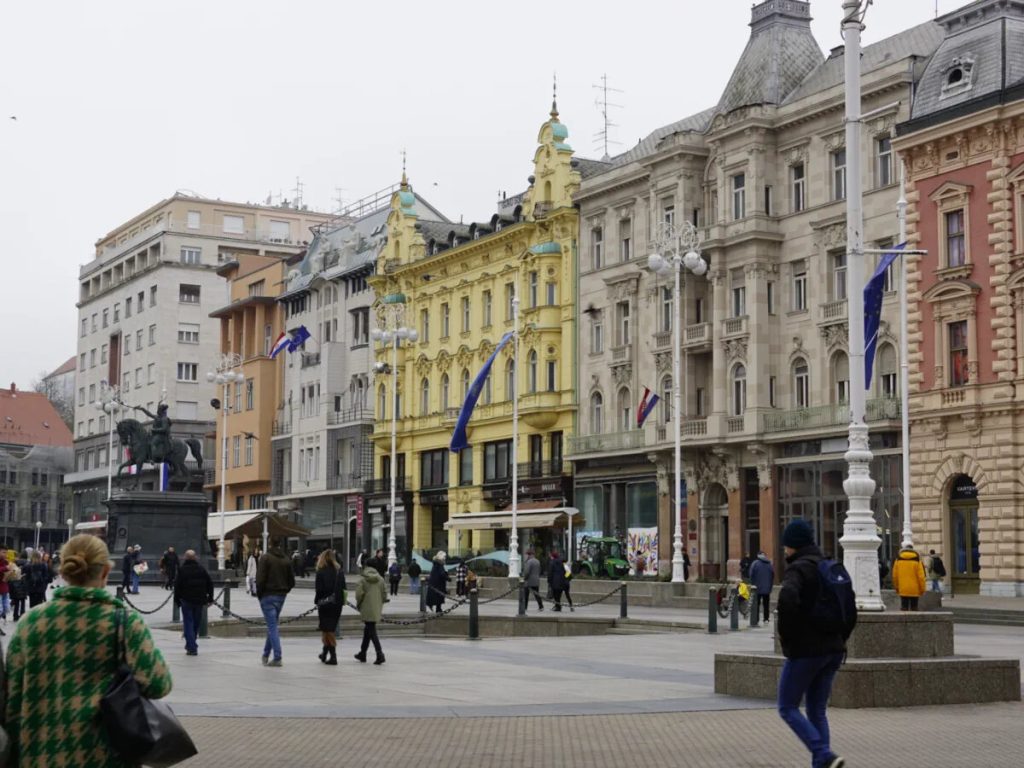



Zagreb’s upper town is built on a hill and where you have hills in Europe, you eventually end up with tunnels. In 1942, the government dug a tunnel system under the old town to be used as a bomb shelter. It’s popular for tourists in the summer because it’s a nice break from the heat. It was popular for us because it was a nice break from the cold and damp. It’s extremely clean (no graffiti) and was fun to walk. Its main shaft is 1,100 feet long (350m) with four shorter offshoots. It also has the dubious distinction of being the first rave club in Croatia in the early ’90s.



After going under the old town in the tunnel, we climbed a bunch of stairs to see what was up there.
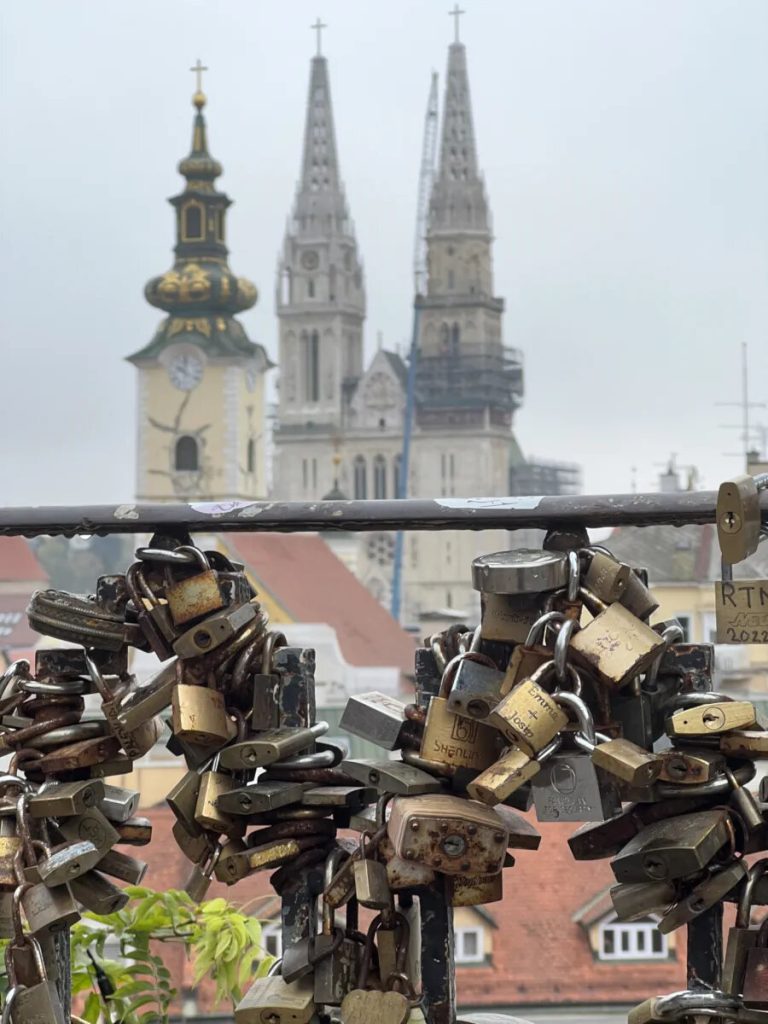


Zagreb has a naïve art museum which I naïvely believed was some kind of mistranslation or typo. “They mean native art, right?” But no, naïve art is not only a real thing but it was an impressive little museum. An yes, it’s quite ironic I had never heard of naïve art.
As someone who is not especially crazy about art museums, I enjoyed this one very much. My metric for rating museums is based on how many times I see something and take a picture in order to look it up and learn more about either the artist or the subject later on. I took a lot of photos in this museum. We especially liked the oil on glass paintings which glowed almost as if they were illuminated from behind.






Nikola Tesla
Nikola Tesla has been famous in Croatia long before Elon Musk entered the scene. An ethnic Serb, Tesla was born in 1856 in the village of Smiljan, which was then considered part of the Austrian Empire’s “Croatian Military Frontier” but today is well within the borders of Croatia proper. He emigrated to the United States in 1884 at the age of 28 and remained in America. If you want to read an interesting article about his identity as a Croatian born ethnic Serb, I found this rather interesting article (note: I have no intention to reinforce any biases by sharing this link. It is a Croatian publication so admittedly may be tinged, but I like the author’s style as well as his message). If you want something more “academic”, the Wikipedia article on Tesla is quite interesting as well. Despite the historical animosities between Croats and Serbs, Tesla’s genius and fame appear to transcend these quarrels as something of a cultural superhero.
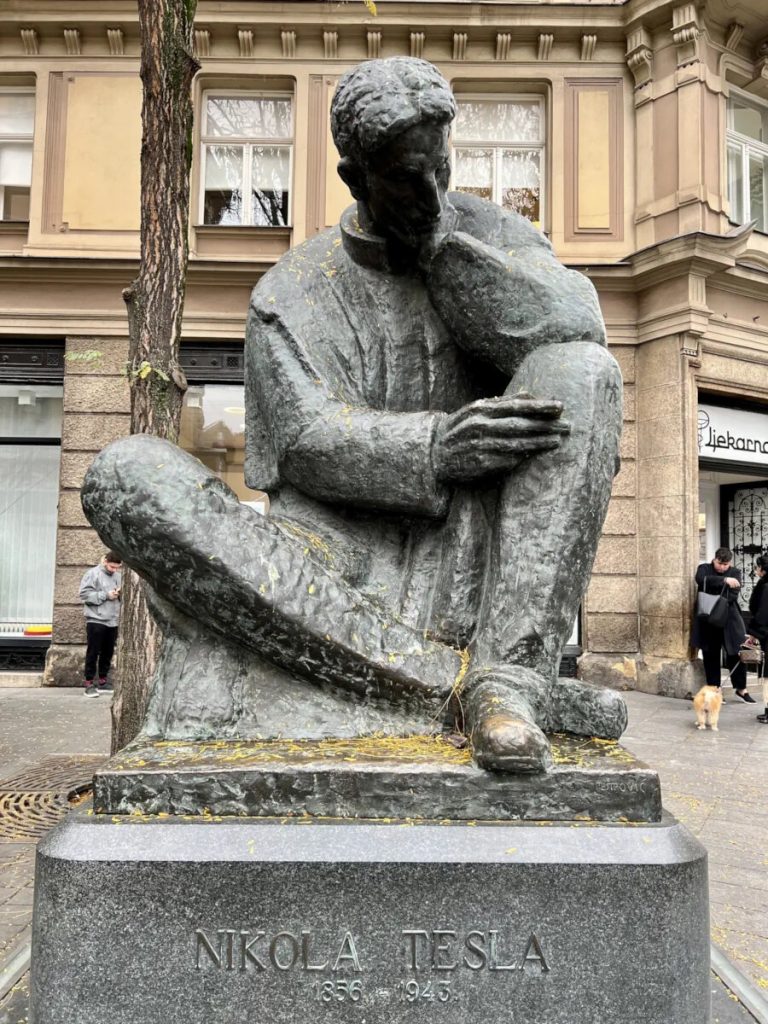

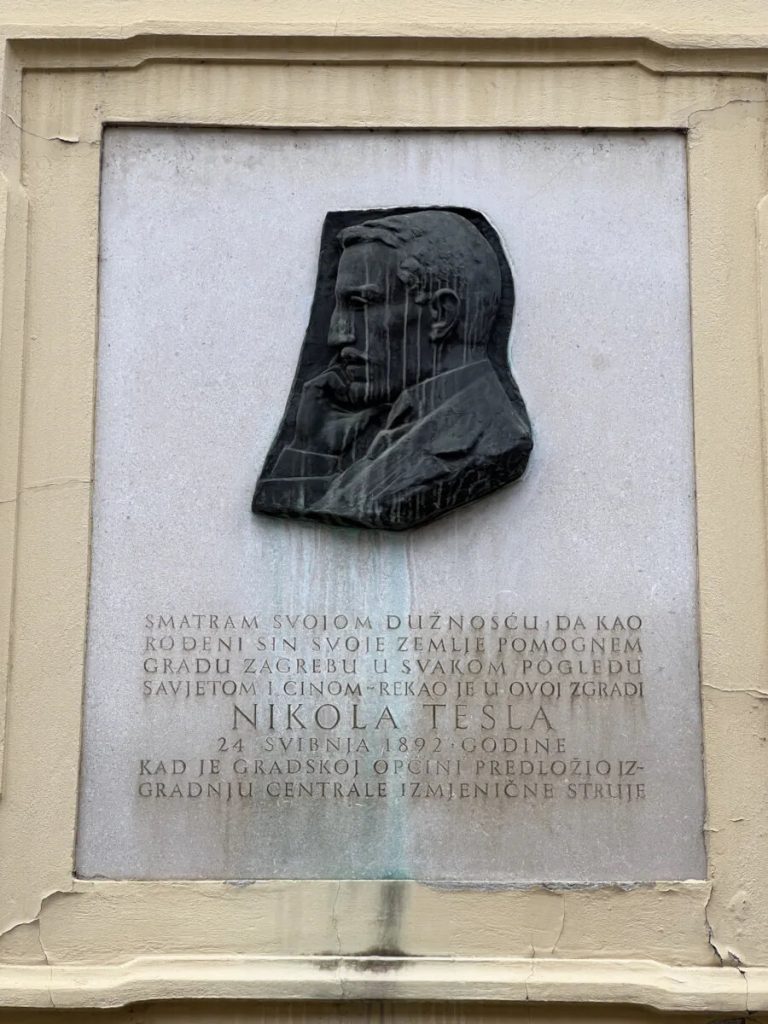
From Croat to Cravat
In addition to claiming Nicola Tesla as a native son, Croatia also proudly boasts that it invented the “cravat” which is the forerunner of the neck tie. Wikipedia backs this claim pretty soundly and tells the story of a Croat regiment that visited Paris in 1660 and created a fashion frenzy with their stunning cravats. It also explains the word “cravat” is a corrupted form of the word Croat. Read more about the cravat here. At the scenic overlook with the lovers’ fence, we found a plaque on the ground which was once accompanied by a squiggly line painted on the ground. The plaque explains the history of the cravat and invites people to position their shadow such that it looks like the squiggly line is a necktie. I would have done it but the squiggly line has been worn away and we had no sun for making a shadow. Not surprisingly, we came across a necktie store not long afterward. It’s all a bit touristy, but underneath the tackiness lies a strong sense of national pride and cultural identity.


Museum Mecca
The Zagreb local travel guide website summed up Croatian history very nicely in its advertisement for the city’s numerous museums. I thought it was worth quoting directly from their website: “Zagreb has the biggest number of museums per capita in the world! As the city is and always will be at the intersection between East and West it lives and breathes history. Unfortunately, within our over 900-year history, we had our fair share of invasion forces. The only benefit from it is the heritage and knowledge they left behind. Most of which is preserved at our museums.” Another big boast, but also another example of the pride and spirit you feel in this city. Zagreb indeed has a bunch of museums covering a broad range of subjects. You can learn more about them at the site I quoted here.
Not far from the Museum of Naïve Art, we came across the Zagreb’s ’80s Museum which is a typical family apartment “preserved” from the 1980’s. Well, we just HAD to check this out and wow, did we have fun stepping back into time. Everything in the museum was interactive, meaning you could sit on the furniture, sift through the books and magazines, choose a recipe from the file box, and play Dig Dug on the makeshift vintage ’80s arcade game console. The museum, of course, had music playing (more Bryan Adams, more Madonna, a little Roxette, and some Scorpions). We even took a little drive, which was great until Lyn closed her eyes.





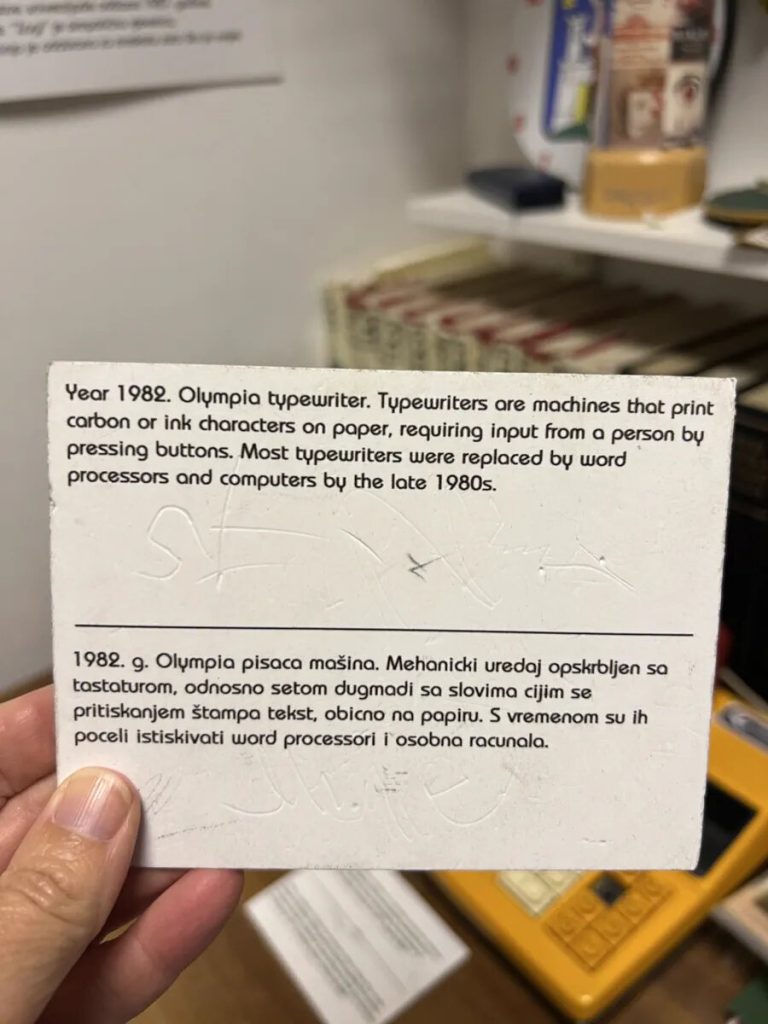






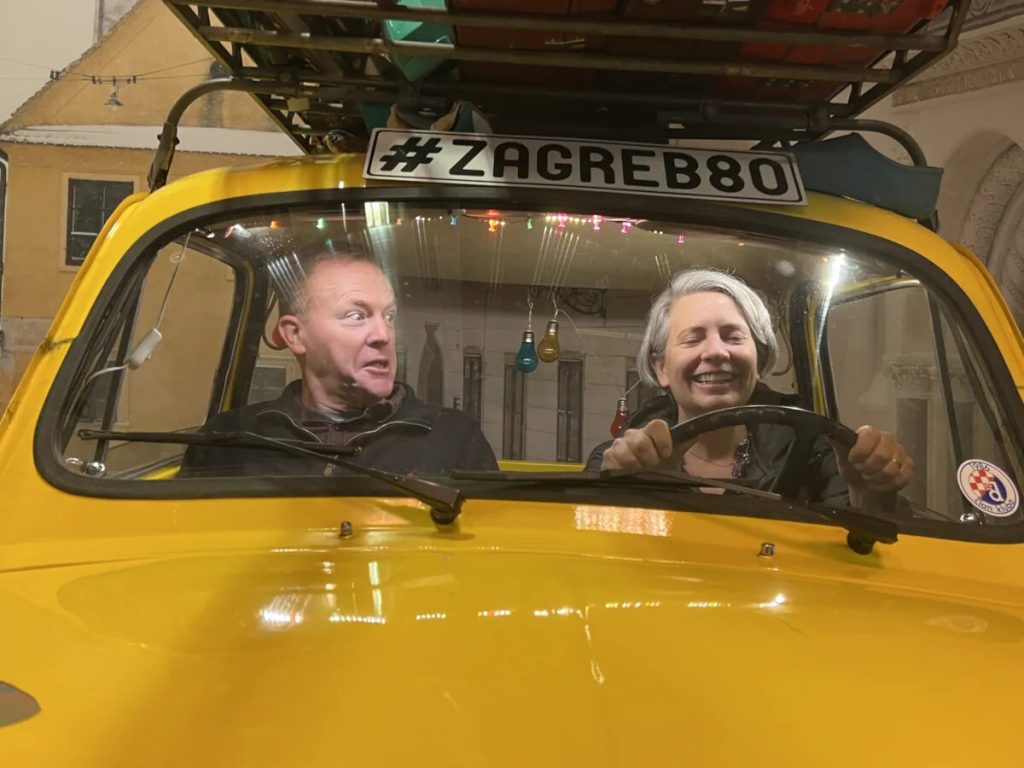
We will see more of Zagreb’s museums when we return. On our list for next time: 1) Technical Museum Nikola Tesla. 2) Zagreb City Museum, 3) Museum of Broken Relationships, and 4) at least one more art museum.
More Wandering in Zagreb




Zagreb at Night




National Remembrance Day
Our second full day in Zagreb was November 18th which we learned (on November 17th) was the Croatian national Remembrance Day or, more specifically, the “Day of Remembrance for the Victims of the Homeland War and Day of Remembrance for the Victims of Vukovar and Škabrnja“.
Without diving too deep into the dissolution of Yugoslavia and the ensuing struggles for independence among its constituent parts, the notable facts of this holiday is that the 87-day Siege of Bukovar ended on November 18th, 1991 with more than 1,000 dead and 2,000 wounded. This was not the only hotspot in the Croatian War of Independence, but it was the most brutal and included the worst of the war crimes committed against Croatians. 1991 is only 31 years ago, so we were humbled by the recognition that war is not an abstract piece of history among contemporary Croatians and that the wounds of civil war are still healing in this historically conflict-ridden part of Europe. The promise of stability and peace under the aegis of EU governance and NATO security are not only important, but practically existential to a nation with such a troubled past.
We were told to anticipate most museums, stores, and restaurants being closed, but it’s hard to completely shut down a European capital city and part of Croatian Independence included shedding the yoke of communist philosophy for good. The free market speaks for itself and we ended up finding a number of restaurants and stores open for business. The holiday cut short our museum execution list though.
Thankfully, we found something even better than visiting tourist attractions to fill most of our day on November 18th.
Bon Dia, Vell Amic
You may recall our friends José and María who we visited in Pedreguer, Spain. We met them through our daughters who were good friends at Cox High School in Virginia Beach. Their daughter Irene spent one year there just after we moved to Virginia Beach from overseas. The girls quickly became close friends and have stayed close since.
Irene is doing her study abroad year (the Europeans call it an “Erasmus” year) in Prague, Czech Republic. Irene had a long weekend so she and a group of her foreign exchange friends hopped on a bus and rode 10+ hours overnight to visit Ljubljana, Slovenia and Zagreb. Through pure luck, their visit to Zagreb overlapped with our brief stop so we arranged to meet up for coffee, which then gave way to a walk around the city in the rain, and then to lunch. We ended up spending five hours with Irene. Lyn had seen Irene in 2017 after Natalie graduated high school and they (Lyn and Natalie) took a trip to Spain. I had not seen Irene since she left Virginia Beach in 2016. As with all old friends though, it felt like no time had passed at all and we filled the five hours quite easily with conversation and laughs. Irene is a bundle of positive energy and her English is extremely good, so that made it quite easy.




Some people on Facebook commented how much Irene looks like Natalie. They certainly are two peas in a pod and it’s fun watching them when they are together. They were born only a week apart, which adds to the special nature of their friendship. We hugged Irene goodbye so she could get back to enjoying Zagreb with other young people.
The rest of the Remembrance Day was fairly quiet. We did a little bit of scouting for a hotel similar to our experience in Madrid and we found a place that should be a significant improvement at only a modestly higher cost next time we visit.
The following day, we started our day slow, packed up our things, departed our subterranean abode, and caught a direct bus to Pula, which covered 160 miles (270 km) in a little over three hours. We were hoping for better weather on the coast but once again the rain cloud followed us.
See you in a few weeks, Zagreb!



